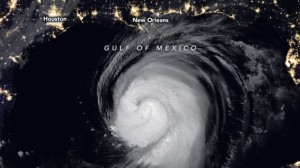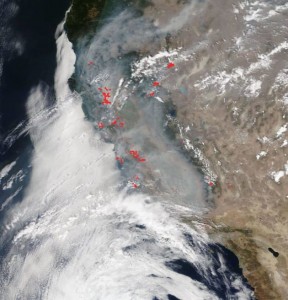
Hurricane Laura in the middle of the night using NASA’s Visible Infrared Imaging Radiometer Suite (VIIRS)
From an Article by Catherine Clifford, CNBC News, August 27, 2020
NASA has released images of Hurricane Laura in the south and of the California wildfires, which bring the scope of the weather events into focus. And both are connected to climate change, according to Paul Ullrich, associate professor of regional and global climate modeling at the University of California Davis.
“Extreme weather events are perhaps the most potent message of the changes taking place in our climate system,” says Ullrich. “Both Hurricane Laura and the California wildfires are connected via a simple rule of thumb that seems to apply fairly generally in describing climate change: wet becomes wetter, dry becomes drier.”
“Warmer global temperatures driven by greenhouse gas emissions have clear downstream impacts on storm intensity, rainfall totals, soil drying, and risk of wildfire,” Ullrich says. “There is no doubt that warming Gulf of Mexico waters have made Hurricane Laura a larger and more intense system, and warmer air temperatures have allowed the storm to carry more moisture and drove up rainfall totals.”
The sea temperatures in the Gulf of Mexico “were running about one degree Celsius (1.8° Fahrenheit) above average,” according to a statement from NASA’s Earth Observatory. “Laura underwent a period of rapid intensification as it passed over the warm Gulf waters, with winds intensifying by 50 miles (80 kilometers) per hour over a 24-hour period.”
Ullrich says that human-driven climate change makes the rainfall worse: “As in the case of hurricanes Florence and Harvey, warming driven by human activity is likely responsible for 10%-50% more precipitation than an analogous storm without human activity.”
Meanwhile, as Louisiana is soaked, large swaths of California & Colorado are burning.
Preliminary estimates of the costs of hurricane Laura are already in the billions. On Thursday, the Insurance Journal sited analyst predictions of an eventual cost of $25 billion.
“There is no doubt that billion-dollar weather disasters are becoming increasingly common. Areas of the U.S. that have historically experienced extreme weather will experience it in the future with increasing intensity,” Ullrich says.
“The way it is looking now is, if we don’t keep emissions in check … these (and other) extreme weather events are likely to worsen,” senior climate scientist with the Union of Concerned Scientists, Astrid Caldas, tells CNBC Make It.
“Unabated anthropogenic climate change will keep the potential for increased fire activity, and the trends observed in hurricanes are not likely to stop either. And we are not even mentioning extreme precipitation and other extreme weather events,” she says.


{ 1 comment… read it below or add one }
Al Gore, Facebook, August 28, 2020
Exactly 15 years ago today, one million people in the Gulf region were displaced by Hurricane Katrina. 1,833 lives were lost, with 40 percent due to drowning. That day made painfully clear our reality: the climate crisis is on our doorstep.
As #HurricaneLaura overwhelms the Gulf Coast, it’s now painfully clear how supercharged these storms are by rising global temps.
At the same time, we are fighting multiple interconnected crises – the pandemic, systemic racism & voter suppression among them. We need a unified & coherent vision for change.
We cannot continue to stand by and watch these disasters unfold. We need to learn from Katrina, Sandy, and now Laura, and demand better. We need leaders that listen to science. We need policies that prepare us for disasters and protect the most vulnerable among us.
My heart goes out to those on the frontlines today. We have a lot of work ahead of us, but there is still hope. Please remember that the will to act is itself a renewable resource.